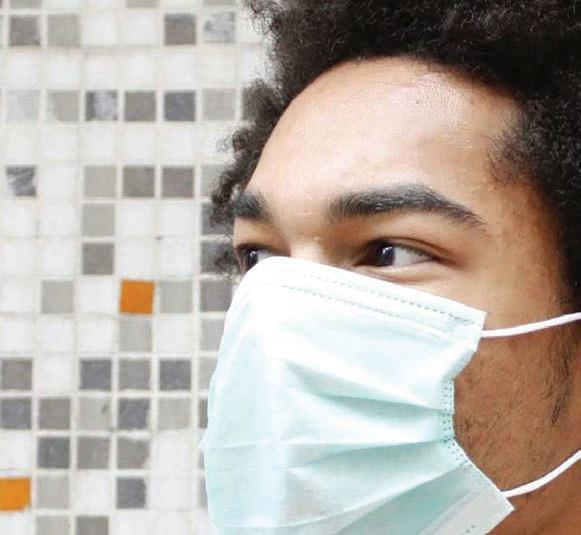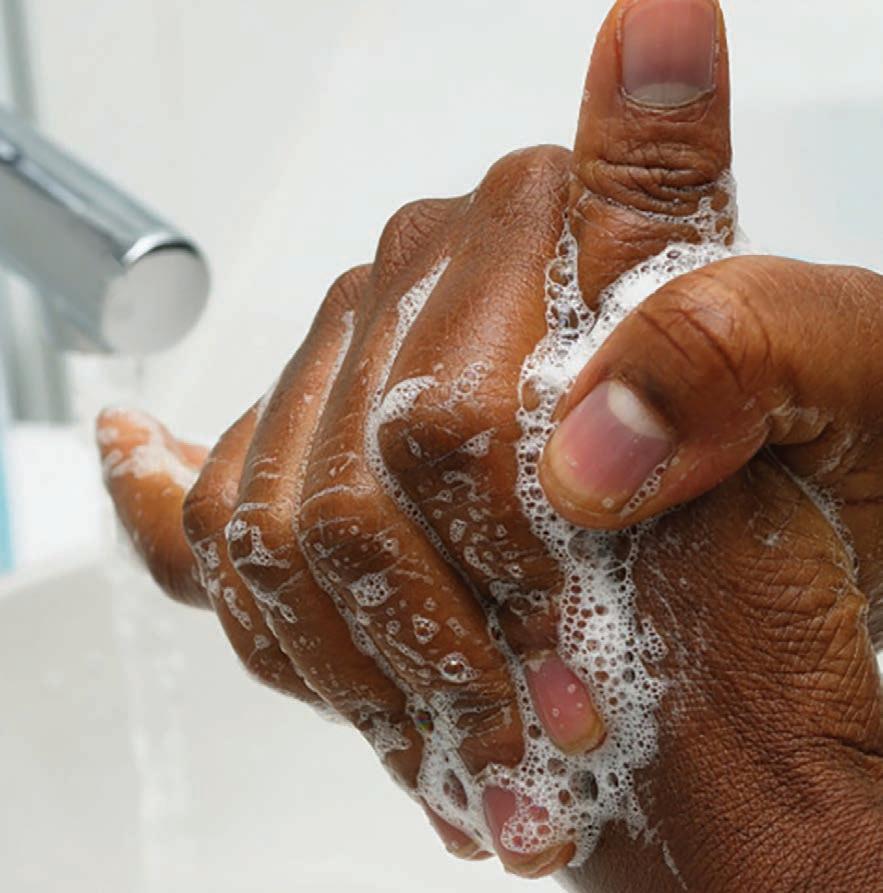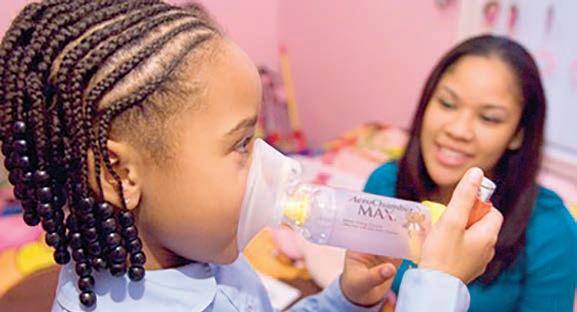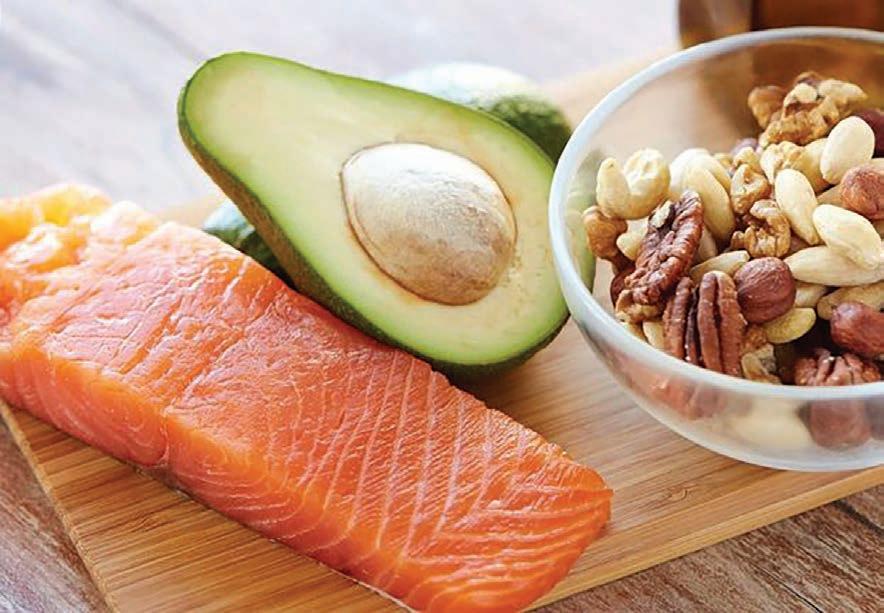
27 minute read
Enjoy your favorite red
COVER YOUR COUGH
Coughing or Sneezing? Please take and wear a mask. Be sure to cover both your nose and mouth when wearing the mask.
Take these steps to keep yourself and the community healthy. If you are sick, STAY HOME. Call us at 202.745.7000 and tell us about your symptoms. These small steps make a big difference in preventing the spread of the common cold, flu and coronavirus.
If you are sick, STAY HOME. Avoid close contact with people who are sick or who are presenting symptoms of frequent coughing or sneezing.
Clean and disinfect surfaces and objects that are frequently touched.
Cover your mouth & nose with a tissue when you cough or sneeze.
Cough or sneeze into your upper sleeve, not your hands. Throw away any used tissue in the waste basket.
Avoid touching your eyes, nose and mouth as these are the easiest areas for germs to spread through.
Pay close attention to your symptoms and seek medical care if your symptoms worsen. If you have not gotten your flu shot yet, get vaccinated for the flu.
Wash your hands with soap and water for at least 20 seconds and dry your hands completely before touching additional surfaces. If soap and water is unavailable, clean your hands with alcohol-based hand sanitizer.
Call our team at 202.745.7000. We will evaluate and treat you over the phone – and help limit your exposure to additional illnesses.
If after your phone evaluation, you still need to come into a Whitman-Walker location, we will coordinate with you to be seen as quickly as possible after you arrive for your appointment. We will also share instructions for wearing a mask.
Copyright © 2020 Whitman-Walker Health.
Additional Resources
whitman-walker.org/careforcoughs How to Manage Your Cough At Home
By Elaine Moquette-Magee Safeway Wellness Services Corporate Dietitian
So you want to avoid getting those winter colds and the flu this season but you may not know that your best defense is to visit your grocery store! Washing your hands frequently and getting your annual flu vaccine are the best ways to limit exposure to flu viruses (and your grocery store can help you do both). But eating foods that help fight the flu by strengthening your immune system is another great way grocery stores can help. Getting plenty of key nutrients and preventing deficiencies which can compromise the immune system is a major key to optimizing your immunity. Enhance your immunity further by including foods contributing key plant compounds with anti-viral and anti-histamine action. 1. Dark green leafy vegetables (such as spinach, kale and broccoli) contribute all three antioxidant vitamins thought to improve immune function (Vitamins A, C, and E) plus they contain Saponins, a plant compound with anti-viral activity. Enjoy a dose of dark green leafy vegetables daily. • Check out these recipes: Simple Sesame Broccoli, 15-Minute Beef, Bean & Spinach Enchiladas
2. Select citrus often! The anti-viral compounds in citrus tend to be in the pulp and white soft flesh around the segments. So eating rather than drinking citrus is ideal. If you are drinking OJ, make sure to buy the type with pulp because that’s where much of the helpful compounds are. Citrus is also bursting with vitamin C and other antioxidants! 3. Maximize mushrooms! They give the immune system a boost in part by enhancing natural immunity! Some mushroom compounds are thought to have inhibitory effects at the first stage of virus replication. Some mushrooms may also have anti-viral, antibacterial and anti-parasitic effects through favorably changing the microbe population living in the intestine, according to recent animal studies. Look for light exposed mushrooms with 100% daily value for vitamin D—vitamin D may help activate the immune system. 4. Seek out surf and turf— Lean beef and select seafood are the top sources of zinc (oysters, crab, beef pot roast, sirloin steak, ground beef, and dark-meat turkey) and zinc is important for the proper functioning of the immune system. You can also find good amounts of zinc in turkey, chicken, lamb, pumpkin seeds, clams, soynuts, and nuts and seeds in general. T cell function declines with age and a recent study with nursing home patients showed that an increase in serum zinc levels was associated with an enhancement of T cell function and number of T cells. (AJCN March 2016 vol. 103 no. 3 942-951)
5. Enjoy your favorite red fruits! Apples, red grapes, tomatoes, berries and cherries give you a nice dose of the plant compound quercetin, which acts as a strong antioxidant and may reduce infection risk and have anti-viral/anti-histamine action in the body. Kale and broccoli, garlic, onions and tea also contribute a dose of quercetin. PROBIOTIC TIP: Include probiotic-rich foods like yogurt and kefir with “live active cultures” and vitamin D each day to help boost immunity and increase good bacteria in your intestines (70% of your immune system is located in your digestive tract.) Also consider a probiotic supplement with good-quality evidence behind it—look for the term “clinically proven” on the label and discuss their use with your
5 Sesame Brocolli
doctor, pharmacist, or dietitian. Keep in mind probiotic benefits are strain and dose specific. BEVERAGE TIP: Drinking hot green/white tea (and to a lesser extent black tea) helps lubricate your sinuses with steam as you drink and adds key compounds with antiviral, anti-histamine and anti-inflammatory action. HS
Fresh, fast, delivered to your door. Shop online and find deals, coupons and personalized offers.


Skip the Line. Order with the App.
It’s Easy. Download Today!
Safeway Delivery & Pick Up App
or visit safeway.com
ALL ORDERS: Service available in select areas. Delivery Companies store banner (that banner’s product availability, pricing and promotions will apply). Online orders require a minimum purchase, unless otherwise noted. Prices for products you order online generally are higher than in Safeway physical stores and may vary by fulfillment method chosen. Online promotions, discounts and offers may differ from those- in Safeway physical stores. Full terms at albertsonscompanies.com/about-us/our-policies/terms-of-use.html
4/21/06
Destination Vaccination Your
• Pneumonia • Shingles • Flu • Hepatitis • HPV • Meningitis

• Tetanus • MMR, and more! *
Walk-ins welcome at our pharmacy! *Available vaccinations vary by location and are subject to state law restrictions.
at your fingertips Pharmacy

Refill, track, & manage prescriptions all in one easy place!
Safeway version
Download our pharmacy app today!
By Lee Ross WI Staff Writer
Americans spend up to 90 percent of their time indoors. Indoor allergens and irritants play a significant role in triggering breathing troubles, including asthma attacks, according to the Environmental Protection Agency (EPA). Triggers are things that can cause symptoms, an episode or attack or make breathing worse and often are overlooked as sources of distress within our homes or in our neigh

Two babies die every hour in the U.S. And about every 12 hours a woman dies as a result of complications from pregnancy. It’s not fine. But together we can do something about it. MARCH WITH US FOR HEALTHY MOMS AND STRONG BABIES
0202 ,9 YAM KRAP SLANOITAN NOITARTSIGER ma 03:8 KLAW ma 00:01
PU NGIS ta gro.seibaBrofhcraM
borhoods. For instance, stuffed animals – carried about by small children are rarely washed or disinfected. Here are few other tips to ridding your home of respiratory triggers to breathing ailments.
Use fragrance-free detergents - Laundry detergents smell so nice, so we wouldn’t see them as a suspect. But we are all clearly wrong with this one. Fragranced products are made of chemicals, so they can contribute to the issue of indoor air pollution. To deal with this, replace the traditional ones with fragrance-free laundry detergents.
Replace the filters - The filters on the air conditioning and heating system play a vital role in keeping your air clean. They trap the particles from the air, such as dust mites and pet dander. If you haven’t checked on the filters, hurry up and do it. You are recommended to do at least 4 checks per year to make sure that the filters are in good shape. If there is lots of accumulated debris, it means that the filters need to be replaced. This is a simple and affordable project that you can do by yourself. Click here to find out more about the best changing practices.
Keep the air dry - A high percentage of humidity in the air contributes to the growth of mold. The mold can release spores in the air, which can trigger asthma and allergies. Make sure that the bathroom is well ventilated. Turn on the exhaust fan after showering or open the window. Another way to keep the humidity away is to check for any leaks in your home. To be on the safe side, check the roof and plumbing often.
Keep the dust mites away - Dust mites are a common reason for allergies. They also thrive in a humid environment, so get a dehumidifier to keep the humidity levels low. Remove the carpets where they aren’t necessary, and make sure that you frequently clean every piece of upholstery in your home. Wash the bedding once a week in hot water to get rid of the dust mites.
Ventilate Daily - Bringing in cleaner outdoor air by opening up windows is the easiest way to dilute the contaminated air in your home. However, you’ll want to keep the windows closed on highpollen-count days or when it’s very humid outside, which can raise the risk of mold.
When cooking and bathing, make sure to ventilate the kitchen with an exhaust fan or nearby open window during cooking, and for at least 15 minutes after you are done preparing the meal.
Vacuum Often and Slowly - Dust is a leading source of air pollution because it absorbs toxic gases, including volatile organic compounds (VOCs) and radon. It can also contain pollen, animal dander, mold spores and dust mites, which are known allergens. Vacuuming slowly and methodically captures the most dust, whereas vacuuming quickly just raises the dust, which defeats the purpose. Vacuum slowly at least twice a week, and step outside to empty the vacuum cleaner bag or canister and avoid inhaling any dust as you do so. HS
National pa rtners
Regional pa rtner

5 Guarding our homes against allergens that negative impact breathing is the first step to having a healthy breathing space. / Courtesy photo

America’s leading beverage companies all want the same thing - a strong, healthy America. That’s why the beverage industry, including The Coca-Cola Company, Keurig Dr Pepper and PepsiCo, are putting aside competitive differences and working together to support consumers’ efforts to balance what they eat, drink and do.
Our companies have introduced more options with zero sugar or less sugar than ever before. We are expanding our offering of smaller portion sizes and we voluntarily removed full-calorie sodas from schools. This unprecedented effort slashed beverage calories in schools by more than 90%. We’re placing clear calorie labels on the front of every bottle and can we sell and we’ve added calorie awareness messages on millions of vending machines and fountains. Today, half of all beverages purchased have zero sugar.
So, next time you go to your local grocer, take a look at the beverage aisle. You’ll see more low- and no- calorie beverages, many more flavored waters, and smaller package sizes such as mini-cans.
America’s beverage companies are committed to working together to achieve real change in people’s lives. Together, we will continue our work to educate consumers about our beverages so they can chose what’s best for themselves and their families. Learn more at BalanceUS.org HS

SUPPORTING YOUR EFFORTS TO FIND BALANCE
By Lee Ross WI Staff Writer
The World Health Organization reported the Coronavirus outbreak has 105,586 confirmed cases (3656 new) – with China registering 80,859 confirmed cases and 3,100 (27 new) deaths. With the U.S. confirming 164 cases and 11 reported deaths, across 19 states (including California, Maryland, and D.C.), health bodies, including the Centers for Disease Control and National Institutes of Health, are wading in to determine how best to treat those infected and halt the spread to healthy populations. This, as many Americans continue to debate the strength of outbreak claims and the potential seriousness of the virus.
“How is the Coronavirus any different than the flu itself? It this something that is being blown out of proportion because of outside factors, politics, or even xenophobia? I do not trust the media reports, but I am also concerned that not taking precautions – in the event this is actually serious – could be deadly,” University of the District of Columbia senior Jordan McAllister told the Informer. “I feel like I need more information.” McAllister’s sentiments echoed across the nation’s capital, with many residents saying the news of contaminations had yet to hit the District and so they felt relatively safe. To that end, the rituals of socializing publicly and traveling had not altered.
Others, like grocery store shelver Royce Bullock, said that they were taking serious steps to ward off the virus – as they would germs in general during cold and flu season.
“I work in the public, I handle boxes, cans, jugs and store items that folks are picking up and putting back all day long. For me it’s like working with children where you have to assume that no one has washed their hands, everything has some type of bacteria on it, and you have to work accordingly,” Bullock said.
He noted that he works with gloves on that start out white and by mid-shift have dust, oils, and indiscernible stains all over them.
“I do not touch my face and I wash my hands for at least two minutes – soap, scrub with a brush under the nails, and up to the elbow, like
the doctors,” he said laughing. “My apron is placed in a bag before I leave the store and tossed into the washing machine at home immediately because I don’t want those germs spread to my car or inside my home.”
The added precautions are necessary as health organizations continue to investigate the outbreak and work to develop suitable treatment protocol. In a February 28 CDC Telebriefing to update media on the Coronavirus (COVID-19), Director of CDC’s National Center for Immunization and Respiratory Disease, Dr. Nancy Messonnier, described measures undertaken by CDC to identify and investigate those suspected of coming in contact with COVID-19.
“At this point in our investigation, we are most focused on symptomatic people who are closely linked to confirmed cases or had travel history. But our criteria also allows for clinical discretion,” she said. “As public health professionals, we know that there is no substitute for the astute clinician on the frontlines of patient care.”
Messonnier said during any infectious disease response there is a great need for test manufacturers to rapidly make testing available in clinics, in hospitals, and at the bedside for People Under Investigation (PUIs).
“This is part of a huge effort within the U.S. government led by HHS,” Messonnier said. “CDC will continue to report case counts on Mondays, Wednesdays and Fridays. Our priority continues to be getting accurate diagnostic capacity—and doing so quickly—because we know public health surveillance is critical to our fight against this novel coronavirus. To date, our strategies have been largely successful. As a result, we have very few cases in the United States. And while we may be confronting the first instance of community spread, we are working very hard with our state and local public health partners to find out more.”
Naturopathic Doctor Dr. LaJoyce Brookshire told the Informer that being proactive against the Coronavirus will help keep Americans healthy when it arrives.
“The CDC announced that it is not a matter of if the Coronavirus is coming to America with an epidem
ic, but when, so we need to stay on the side of prevention. I need you to keep your hands clean with things like wintergreen alcohol and witch hazel – I like to make a mixture with peroxide so I can spray my hands and spray down surfaces,” Brookshire said. “What’s dangerous about the Coronavirus is that it lives on surfaces and that makes it especially dangerous.”
Brookshire also advises that Americans boost their immunity by adhering to the lifestyle wisdom of elders that included listening to our bodies and resting as needed.
“Go to bed, drink your green juices, drink plenty of water, eat healthy soups and fresh meals that you make at home so that you are able to stay on the side of wellness instead of trying to repair the body afterwards,” Brookshire said. HS

5 Forewarned, is forearmed in the case of the Coronavirus, which American health officials believe will impact the nation’s respiratory systems in coming weeks. / Photo courtesy of CDC
Tips to Avoiding Coronavirus
WI Staff Report Courtesy of The World Health Organization

WASH YOUR HANDS FREQUENTLY
Regularly and thoroughly clean your hands with an alcohol-based hand rub or wash them with soap and water.
Why? Washing your hands with soap and water or using alcohol-based hand rub kills viruses that may be on your hands. MAINTAIN SOCIAL DISTANCING
Maintain at least a 3-foot distance between yourself and anyone who is coughing or sneezing. Why? When someone coughs or sneezes, they spray small liquid droplets from their nose or mouth which may contain virus. If you are too close, you can breathe in the droplets, including the COVID-19 virus if the person coughing has the disease. AVOID TOUCHING EYES, NOSE AND MOUTH Why? Hands touch many surfaces and can pick up viruses. Once contaminated, hands can transfer the virus to your eyes, nose or mouth. From there, the virus can enter your body and can make you sick. PRACTICE RESPIRATORY HYGIENE
Make sure you, and the people around you, follow good respiratory hygiene. This means covering your mouth and nose with your bent elbow or tissue when you cough or sneeze. Then dispose of the used tissue immediately. Why? Droplets spread virus. By following good respiratory hygiene, you protect the people around you from viruses such as cold, flu and COVID-19. IF YOU HAVE FEVER, COUGH AND DIFFICULTY BREATHING, SEEK MEDICAL CARE EARLY
Stay home if you feel unwell. If you have a fever, cough and difficulty breathing, seek medical attention and call in advance. Follow the directions of your local health authority. Why? National and local authorities will have the most up to date information on the situation in your area. Calling in advance will allow your health care provider to quickly direct you to the right health facility. This will also protect you and help prevent spread of viruses and other infections.
By Lee Ross WI Staff Writer
Asthma, a chronic lung disease, is accompanied by symptoms like wheezing, coughing, chest tightness, and shortness of breath. During an asthma attack, the sides of the airways swell, and the airways shrink, making it harder to breathe. Children suffering with asthma often experience fear and anxiety, along with the physical symptoms – especially when not with parents.
Once considered rare, asthma is now a common disease in childhood with roughly 6 million children impacted in the U.S. alone. Respiratory therapist Fuanmbai Turay told the Informer that small children may be more sensitive to environmental triggers of asthma and therefore, parents should ensure they have an action plan for the child whether at school or at home.
“Children naturally want to run and play or may have a favorite blanket or toy that they latch onto that has not been cleaned in years that trigger breathing difficulties – or full attacks,” Turay said. “The goal is to ensure that children entering school are able to communicate their discomfort to teachers and other staff.”
The American Lung Association advises that children with asthma need a bronchodilator (or rescue inhaler) – like Albuterol -- to treat coughing, wheezing and shortness of breath that occur with symptoms or an asthma attack. Rescue inhalers should be with asthmatic chidlren at all times for use at the first sign of symptoms. Some children may require an anti-inflammatory as well, to manage swelling of the bronchial tubes and prevent flare-ups.
Turay said that as many young children and teens travel to school daily without a parent, it is important that they understand what environmental agents can trigger attacks.
“Triggers can be almost anything, because all children are different. One client experienced breathing difficulty on morning commutes on public transportation when she encountered lots of perfumes, hair sprays, and deodorizers while on closed-in subway cars; another encountered dangers doing research surrounded by moldy books in the stacks of a library,” Turay said. “When you also factor in things like second-hand cigarette smoke, pollen, pet dander, and abrupt changes in the weather, a child must be prepared to fight for their breath at any moment.” Asthma remains one of the leading causes of missed time from school and work. Severe asthma attacks may require emergency room visits or hospitalizations and can be fatal. And while asthma impacts children of all ethnic groups, Black children are 4 times more likely to be admitted to the hospital for asthma, compared to non-Hispanic white children.
A study presented at the 2017 American Academy of Allergy, Asthma & Immunology (AAAAI) Annual Meeting called “Where Do Children with Asthma Die? A National Perspective from 2003 to 2014” addressed where and which demographics of children faced death related to asthma in the United States.
The researchers used National Center for Health Statistics data to examine 2,571 pediatric asthma deaths between 2003 and 2014 and found that

the mortality rate among Black children was six times higher than among Hispanic or white children.
“Deaths from asthma, especially among children, are sentinel events that can be avoided with timely interventions,” said Anna Chen Arroyo, MD, MPH, of Brigham and Women’s Hospital and lead author of the study. “Studying the location of asthma deaths provides important insight that can help target efforts to prevent future deaths.”
Turay stressed the importance of teachers, school administrators, and childcare providers being made aware of a child’s asthma and ways to manage it in the absence of the parent.
“I recommend parents have what is known as an Asthma Action Plan that lists known triggers, medications, and contact information for parents in case of an attack,” Turay said. “Some children are too young to recognize what is happening, while others may be under duress and unable to help themselves, so we all play a part in helping our children breathe better.” HS 5 Knowing what triggers a child’s asthma attacks and ways of managing the condition are keys to better breathing in children. / Courtesy photo
No matter what pops up, getting care has never been easier
We’re here in Ward 5 seven days a week, and online 24/7
Get the care that’s right for you with Providence Health System. Schedule routine care online with a Providence doctor. Or see a doctor online 24/7 — from wherever you are — with Ascension Online Care. No insurance required and available in all 50 states and the District of Columbia.
Find it all at GetProvidenceDCCare.com
CALENDAR in 15min 24

ALERT: Flu Symptoms in 15 Min
Primary Care | Urgent Care | Online Care
© Ascension 2020. All rights reserved.
By Lee Ross WI Staff Writer
Breathing troubles – whether attributed to environmental triggers, chronic conditions, or failing organs – impact millions of Americans daily. Always consult and follow the instructions of your physicians, and when in need of additional information, search it out. Here are a few recent and recommended books on living with breathing ailments that make a great start.
UNDERSTANDING ASTHMA By Holly Duhig - Asthma is a very common condition among children and adults. In fact, a recent study found that 1 in 12 children had asthma. This informative book introduces readers to asthma symptoms, how it affects the body, and treatment in a clear, straightforward way. It simplifies complex medical concepts into age-appropriate text. Full-color photographs and fact boxes highlight important information. This accessible book is perfect for readers who are learning to care for their own asthma, or who have loved ones with asthma.
ASK THE GOOD DOCTOR: THE DETOX EDITION REMIXED FOR A HEALTHY NEW YOU By LaJoyce Brookshire
In this REMIX of the 2011 Edition, New York Times Bestselling-author Dr. LaJoyce Brookshire presents a stepby-step full-body detox in 7 easy steps with food and product suggestions, that will boost your immune system against viruses. Dr. Brookshire defines a detox as shortterm intervention designed to eliminate toxins from the body to promote health by creating the perfect conditions within to support the body do its job. So, if you constantly feel fatigued, experience frequent headaches, have lack of mental clarity, seasonal allergies, packing on excess pounds, and have sluggish eliminations ... then it is time to tune-up by initiating a detox.
Let’s share the goal of making a Healthy Community our #1 Priority.
BREATHING IN AMERICA: DISEASES, PROGRESS, AND HOPE By Dean E. Schraufnagel
Breathing in America: Diseases, Progress, and Hope explores the nature and causes of pulmonary, critical care, and sleep disorders, their prevalence and burden, the benefits research has brought, and the research challenges that remain. Written for educated laypersons, the book presents basic facts about twenty-three different respiratory conditions, features a case study for each condition, and highlights the most promising areas of research.
Spread your message in The Washington Informer’s 2020 Health, Wellness and Nutrition Special Sections









Celebrating Nurses On the Front Line of Health Care Publication Date: May 14 Deadline: April 29 (National Nurses Week Observances)
Raising a Healthy Child Publication Date: August 13 Deadline: August 5
Holiday Health & Nutrition Publication Date: December 12 Deadline: December 4
• Individual or package options are available • To reserve your space contact: hcarter@washingtoninformer.com
Visit us online: WashingtonInformer.com Twitter: @WashInformer | Facebook: WashingtonInformer | Instagram: @WashInformer
ASTHMA, COPD, AND OVERLAP: A CASE-BASED OVERVIEW OF SIMILARITIES AND DIFFERENCES By Jonathan A. Bernstein, Louis-Philippe Boulet, Michael E. Wechsler
Using illustrative case examples, this book thoroughly reviews similarities and differences between asthma, chronic obstructive pulmonary disease (COPD) and the overlap syndrome. It is important to highlight the distinctions because these commonly encountered conditions in respiratory and primary care share many similarities but have important differences often mistaken for each other. This practical guide shows how to distinguish between the diseases on a pathological and clinical basis so that appropriate management and treatment may be pursued.
AMERICA BREATHING EASIER By The Centers for Disease Control and Prevention, U. S. Department of Health and Human Services, National Program
CDC’s National Asthma Control Program plays a critical role in helping America breathe easier by learning more about asthma and how to control it. Four thousand people die each year from asthma-related causes, and asthmas is a contributing factor in another 7,000 deaths every year. In asthma, something – air pollution, allergens, exercise, stress, certain chemicals in the workplace – causes the airways of the lungs to narrow or become blocked, making it hard to breathe. HS
SHIRE Wellness Circles Supporting Empowerment for Our Health and Well-Being
One evening in March 2010, SHIRE representatives sat with 20 Ward 8 residents in a meeting room at Matthews Memorial Baptist Church. Everyone had diabetes, hypertension or another chronic illness. They wanted to know how to manage these conditions and how to prevent complications. They wanted to know about medications. They asked for information to equip them to take charge of their health. SHIRE listened and realized that they were talking about being as well as possible even with a chronic condition. They were transcending the concept of health, which traditionally has been the absence of disease. They were talking about wellness, which encompasses not only physical health but the totality of an individual – mind, body and spirit. It became crystal clear that our participants wanted to learn how to be well even while living with a chronic condition and they needed tools and support to achieve that goal.
SHIRE’s mission since 1997 has been to help eradicate health disparities, and aid African Americans and other people of color attain optimal health and well-being. Aware of the disproportionately high levels of diabetes (nearly 1 in 5 adults) and hypertension (nearly 2 in 5 adults) in Ward 8, we have implemented many programs involving youth and adults in southeast Washington.
Our discussions in Ward 8 became a springboard. Wellness Circles became the vehicle to translate mission into action in a new way. With the nurturing of Canary Girardeau, SHIRE’s senior program associate, Wellness Circles took shape. First, we refined the message. We can be well while living with diabetes, high blood pressure or any other condition if we do three things: First, we learn all we can about our condition so we can hold informed discussions with the health providers who serve us. Second, we make the lifestyle changes needed to manage, control and ideally improve or reverse the condition. Third, we empower ourselves to become our own best health advocates and coaches. Key to the achievement of these aims would be creating a “circle” of support from others experiencing similar challenges to encourage Wellness Circle participants to make changes that enhance wellness.
Our next step was to develop Wellness Circles that supported participants in achieving these goals. We created a series of 6-8 sessions with these features: • Presentations by down-toearth experts on chronic conditions; healthy eating, wise shopping and food preparation; reducing stress; medications and their purpose. • Physical activity (e.g., chair exercises, yoga, Tai Chi) at each session. • Goal setting, participant interaction, testimonials • Healthful meals • Incentives, such as gift cards for each participant, door prizes, and prizes for setting healthy living goals and achieving them • Celebration and recognition ceremonies with awards for health improvement and attendance
Key to the success of Wellness Circles are peer educators who recruit participants and stay in communication with their recruits to encourage sustained attendance. These SHIRE team members live in the neighborhoods where they recruit and are former Wellness Circle participants.
To date, with support from AmeriHealth Caritas District of Columbia and the Government of the District of Columbia SHIRE has engaged over 1,000 community residents. Documented results confirm the power and impact of Wellness Circles. In our last series for example, 81% reduced their blood pressure levels and similar results have been posted in previous series. Our vision is to see Wellness Circles for DC residents of all ages in every part of the city and we welcome partners who share our dream.
For more information, please visit our website @ www.shireinc. org and contact SHIRE at rperot@ shirienc.org
Authors: Ruth T. Perot, Canary Girardeau and Dawn Covin, Summit Health Institute for Research and Education, Inc. (SHIRE) HS


WELLNESS CIRCLES TO IMPROVE MANAGEMENT OF METABOLIC CONDITIONS






